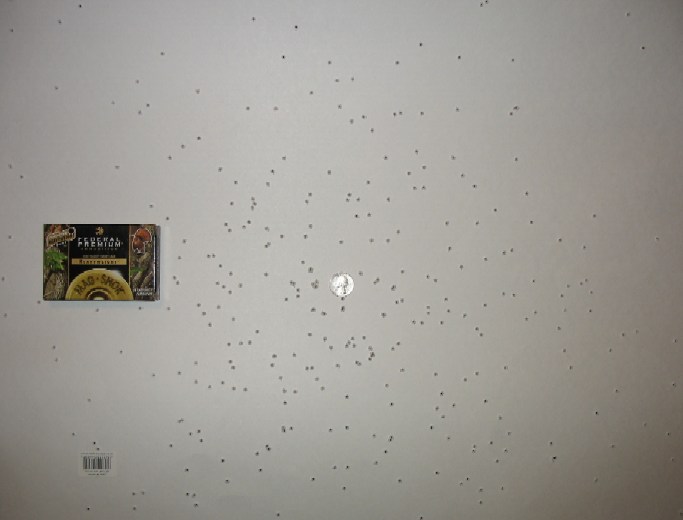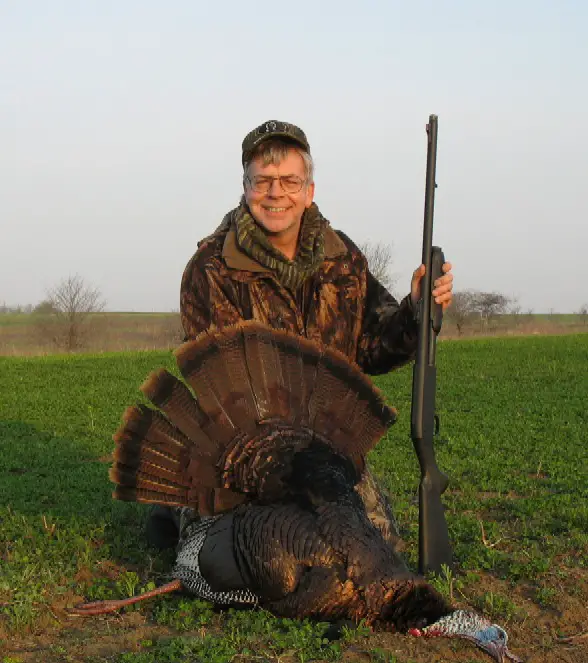


Federal Heavyweight Turkey Load in 12 Gauge Equals Fabulous Performance

A representative pattern at 42.5 yards out of a stock Ithaca Turkeyslayer 12 gauge, just as supplied.
I've been waxing enthusiastic about Federal's Heavyweight #7 turkey loads in 20 gauge for some time now. They remain the most devastatingly good 20 gauge turkey loads I've ever experienced. What I had not had the opportunity to do is to try out the 12 gauge version of this load, that is until today. The results were nothing short of incredible.
Very recently, I covered the new Ithaca Turkeyslayer 12 gauge. The Perma Guard makes the Ithaca Turkeyslayer slick as can be, the iron sights makes target acquisition both instant and precise, and the patterns were also impressive. Well, those patterns just got even better with the 1-5/8 oz. 3 inch Federal Heavyweight 12 gauge loads.
One of the challenges that Federal likely has with #7 Heavyweight loads is the preconcieved notion many, if not most of us have about "#7 shot." I like straight #7 lead shot, having used it for years for the race games and for long range dove hunting with Green Dot reloads. A turkey's head and neck has very little in common with clays games or dove hunting, to be sure. But, Federal Heavyweight #7 isn't your grandfather's #7 lead load, to make the understatement of the year.
This 1-5/8 ounce turkey load boasts a 353 pellet count in #7 configuration. 1.625 ounces equates to right at 711 grains. This means the little #7 Heavyweight sphere weighs about 2 grains. According to Lyman, 1-5/8 oz. of #7 lead is 481 pellets for a weight per pellet of 1.478 grains per pellet. Federal's Heavyweight weighs more than one third more than lead. This makes all the difference in the world.
Larger lead pellets carry better, lose less velocity, and penetrate better than smaller pellets. The reason they do is not because they are larger, for a larger sphere of the same mass flies horribly compared to smaller spheres. Larger spheres have to push more air in concert with their increased size, lowering the ballistic coefficient substantially. A regulation ping-pong ball weighs 2.4 grams (37.0376 grains) and is 40mm in diameter. Though the mass is 25x the weight of a piece of #7 lead shot, we won't be dropping doves with ping-pong balls anytime soon as the lack of density makes them bleed velocity so very rapidly. Larger lead pellets carry farther because lead is a dense enough material that the advantage of greater weight overcomes the disadvantage of a larger diameter having to push more air.
Federal #7 Heavyweight resides somewhere between #5 and #6 lead shot in weight per pellet. Since it has a smaller footprint to push air with, it loses less velocity than either one, penetrates deeper than either one both due to higher impact velocity and a slightly smaller wound channel. It handily outpatterns both as the far stronger, tougher Heavyweight does not deform. It also penetrates better than both again due to lack of deformation on impact-- just the ticket when breaking bones is the idea.
The idea of a #7 pellet blowing clean through 3/16 in. plywood at forty yards may seem impossible, but that's exactly what the #7 Heavyweight did. There is no question in my mind that #7 Heavyweight outperforms #5 lead at all ranges, with less wind-drift and drop as well.
As a matter of course, I use 22 inch x 28 inch cut sheets of thick posterboard to pattern. They are easy to staple up, do not tear easily, and the more pronounced exit holes show up well for illustrative purposes. I placed a quarter at the point of aim to give you a better idea of scale. Using the more generous industry convention of a 30 inch circle at 40 yards, this load yields essentially 100% patterns out of the Ithaca Turkeyslayer 12 gauge.
I suppose Federal Premium took into consideration the old notions of what #7 shot is capable of, as they offer this same load in #5 and #6 Heavyweight as well. No need, as far as I'm concerned, unless you think you might need to shoot through small trees to get to your turkey. You pay a hefty price in pellet count when you go unnecessarily large. While the #7 load gives you 353 pellets, # 5 and #6 Heavyweight equates to 270 and 206 pellets, respectively. No need and no thanks. The #7 Heavyweight is all anyone could hope for. At a stated 1300 fps MV, though certainly no skeet load, this Federal 3 inch load is quite manageable in the recoil department as well.
It is a thoroughly satisfying, if not startling good turkey shell that handily outpatterns every conventional load I've ever tried, including some teeth-rattling shoulder-busting 2-1/4 oz. 3-1/2 inch #5 lead loads, by no small measure. Pattern a pack of these shells out of a quality gun with a quality choke and you'll be a believer as well.
For more info on the shells, see http://www.federalpremium.com/products/shotshell.aspx . The tested load is Federal # PHT193F. For more info on the new Ithaca Turkeyslayer, see http://www.ithacagun.com/ .
Postscript, 3/12/2010.

Tony Knight, the father of modern muzzleloading, lured this 2-1/2 year old twenty-four pound Iowa gobbler within roughly 37 yards. Both the Ithaca Turkeyslayer and a Federal Heavyweight #7 shell did their respective jobs.
Copyright 2010 by Randy Wakeman. All Rights Reserved.




